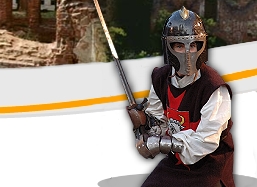|
Insterburg Castle in Chernyakhovsk
In 1275, the Teutonic Knights set off to
subdue Nadrovia. A Prussian stronghold called Nettinen or
Letowie (today Krasnaja Gorka) served as their base for attacks
and defence. For many centuries before, these earthen and
timber fortifications had been used by Baltic Prussian as
a safe haven.
In 1311, Teutonic mercenaries called Landsknechts set up a
camp on the high banks of the Angrapa River, close to where
it flows into the Inster River. Later, in 1337, the Teutonic
Knights built a brick castle in the same location. Most of
the construction works had been completed by 1347. The fortress
was named Insterburg Castle. The word 'inster' in the Baltic
Prussian language was the name of the river on which the castle
was raised, and used to be translated as 'flowing'. The word
'burg' meant 'a stronghold' in German. The whole name 'Insterburg'
was translated as 'a fortress on water'.
For many centuries to follow, Insterburg
Castle was a bastion located in the easternmost parts of the
Teutonic State, from which raids against Lithuania were waged.
Originally, Insterburg Castle was meant to serve as a seat
for the local commander, known as komtur. But this plan had
to be revoked, as the fortress was constantly threatened by
enemy. As a result, the castle was run by a Teutonic procurator,
and in the 14th - 15th centuries it became an important military
base. In the administrative division, Insterburg belonged
to the commandry of Königsburg.
From 1643 to 1647, Maria Eleonora, a sister
of the Prussian Prince Elector George Wilhelm, spent her best
days at Insterburg Castle, after her royal husband, King of
Sweden, Gustaw Adolf, had died. Following the death of her
husband, Queen Maria Eleonora had to leave Sweden due to a
conflict with her daughter, Queen Christina.
In 1812, the castle was visited by the French
Emperor, Napoleon Bonaparte. Napoleon stopped here on his
way to Russia, where he was going to take personal command
over his armies. In 1814, Elisabeth Alexeievna, the wife of
Tzar Alexander I of Russia (1777-1825) was passing through
Insterburg. In 1689, Insterburg became the place of the death
and burial of Anchen von Tarau, a heroine of a well known
East Prussian song.
Today the castle, which lies in the centre
of the town of Chernyakhovsk is no more but a picturesque
ruin. The north section of the castle outward yard had more
luck as its building have survived and now house a museum.
On the square in front of the museum local enthusiasts and
artists such as singers and musicians organise concerts, contests
and other cultural events. And most importantly, hope lingers
on in the town that one day the castle will be reconstructed.
|






![]()
![]() On
the trail of the castles in the Baltic Sea region - revitalization and promotion
of the objects
On
the trail of the castles in the Baltic Sea region - revitalization and promotion
of the objects